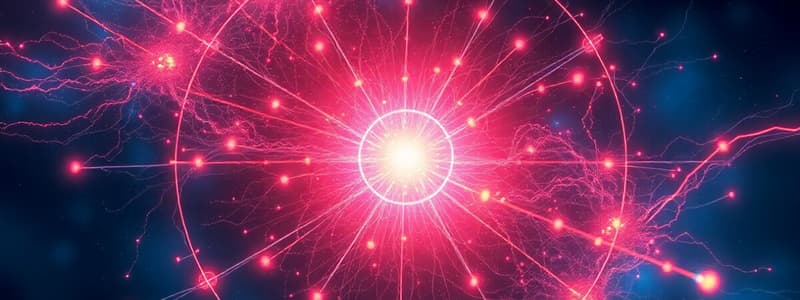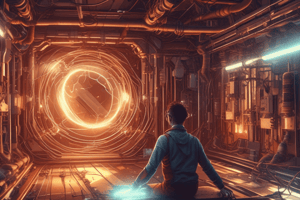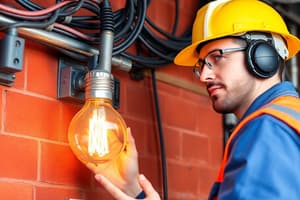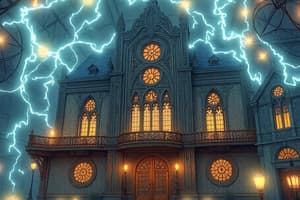Podcast
Questions and Answers
What is the charge of an atom when it has more electrons than protons?
What is the charge of an atom when it has more electrons than protons?
- Neutral charge
- Variable charge
- Negative charge (correct)
- Positive charge
Which subatomic particle is located in the nucleus and carries a positive charge?
Which subatomic particle is located in the nucleus and carries a positive charge?
- Ion
- Electron
- Proton (correct)
- Neutron
Which of the following best describes the nature of electricity?
Which of the following best describes the nature of electricity?
- It is the force between neutrons.
- It is the flow of electrical power or charge. (correct)
- It is a type of ion.
- It is the mass of an atom.
What happens to electrons in an atom when a force is applied?
What happens to electrons in an atom when a force is applied?
What particle in an atom has no charge and can vary in number?
What particle in an atom has no charge and can vary in number?
In terms of electricity generation, what are primary sources of energy often associated with?
In terms of electricity generation, what are primary sources of energy often associated with?
What defines whether an atom is positively or negatively charged?
What defines whether an atom is positively or negatively charged?
What does the term 'ions' refer to in the context of atoms?
What does the term 'ions' refer to in the context of atoms?
What occurs during charging by friction?
What occurs during charging by friction?
Which characteristic is true about insulators?
Which characteristic is true about insulators?
What is the primary function of a resistor in a circuit?
What is the primary function of a resistor in a circuit?
What distinguishes a diode from other electrical components?
What distinguishes a diode from other electrical components?
What role does a capacitor play in an electrical circuit?
What role does a capacitor play in an electrical circuit?
Which of the following statements is true regarding static electricity?
Which of the following statements is true regarding static electricity?
What best describes the flow of current in an electrical circuit?
What best describes the flow of current in an electrical circuit?
How does a variable resistor or potentiometer function?
How does a variable resistor or potentiometer function?
What is static discharge and how does it differ from the flow of current?
What is static discharge and how does it differ from the flow of current?
Explain the role of insulators in electrical systems.
Explain the role of insulators in electrical systems.
What is the significance of a diode in an electrical circuit?
What is the significance of a diode in an electrical circuit?
How do resistors function within an electrical circuit?
How do resistors function within an electrical circuit?
Discuss the process and outcome of charging by conduction.
Discuss the process and outcome of charging by conduction.
What unique function does a capacitor serve in an electrical circuit?
What unique function does a capacitor serve in an electrical circuit?
Define the relationship between current and conductors.
Define the relationship between current and conductors.
Explain how the imbalance between protons and electrons in an atom creates an ion.
Explain how the imbalance between protons and electrons in an atom creates an ion.
Describe the relationship between electrons, protons, and electrical charge in an atom.
Describe the relationship between electrons, protons, and electrical charge in an atom.
Discuss the role of energy sources in generating electricity.
Discuss the role of energy sources in generating electricity.
How do moving electrons constitute electricity?
How do moving electrons constitute electricity?
What is the significance of the shells around the nucleus in an atom concerning electrical charge?
What is the significance of the shells around the nucleus in an atom concerning electrical charge?
In what way do neutrons differ from protons in an atom?
In what way do neutrons differ from protons in an atom?
What is the definition of electricity based on its flow and charge?
What is the definition of electricity based on its flow and charge?
How does the movement of electrons relate to the concept of electric forces between protons?
How does the movement of electrons relate to the concept of electric forces between protons?
Flashcards are hidden until you start studying
Study Notes
Types of Electricity
- Electricity is defined as the flow of electrical power or charge.
- Primary energy sources for electricity generation include coal, natural gas, oil, and nuclear power.
- Electricity can be generated from both renewable and non-renewable sources, but is considered neither.
Atoms and Electricity
- Atoms are the smallest unit of matter, made up of protons, neutrons, and electrons.
- The nucleus of an atom contains protons (positive charge) and neutrons (no charge).
- Electrons (negative charge) orbit around the nucleus and can gain or lose energy, impacting their movement.
- Ions are charged atoms or molecules, determined by the imbalance of protons and electrons.
Charged Particles
- An atom's overall charge is calculated by subtracting the number of electrons from protons.
- Electrons in outer shells can be displaced through force, resulting in movement of charge, which constitutes electricity.
- Opposite charges attract; therefore, protons and electrons interact to maintain atomic stability.
Static Electricity
- Static electricity occurs due to an imbalance of charges and can be generated through methods like friction, conduction, and induction.
- Static discharge refers to the rapid flow of electrons; lightning is a natural example of this phenomenon.
Current Electricity
- Current is the ordered flow of charged particles, typically through a conductor (like a wire), used for everyday electrical needs.
- Conductors (e.g., metals) allow electricity to pass, while insulators (e.g., plastics and rubber) prevent current flow, providing safety.
Electrical Components
- Resistors: Limit current flow in a circuit and convert some electrical energy into other forms (light, heat, etc.).
- Capacitors: Store electric energy, retaining charge even when disconnected from the power source.
- Diodes: Allow current to flow in one direction, offering protection to electronic circuits through blocking reverse currents.
- Variable Resistor/Potentiometer: Adjust resistance manually, affecting the current in a circuit by turning a dial.
Summary of Properties
- Insulators protect against unintended current flow, making handling safer.
- Resistors control voltage and current, ensuring proper functioning in electrical circuits.
- Capacitors and diodes play crucial roles in managing energy storage and current direction.
Types of Electricity
- Electricity is defined as the flow of electrical power or charge.
- Primary energy sources for electricity generation include coal, natural gas, oil, and nuclear power.
- Electricity can be generated from both renewable and non-renewable sources, but is considered neither.
Atoms and Electricity
- Atoms are the smallest unit of matter, made up of protons, neutrons, and electrons.
- The nucleus of an atom contains protons (positive charge) and neutrons (no charge).
- Electrons (negative charge) orbit around the nucleus and can gain or lose energy, impacting their movement.
- Ions are charged atoms or molecules, determined by the imbalance of protons and electrons.
Charged Particles
- An atom's overall charge is calculated by subtracting the number of electrons from protons.
- Electrons in outer shells can be displaced through force, resulting in movement of charge, which constitutes electricity.
- Opposite charges attract; therefore, protons and electrons interact to maintain atomic stability.
Static Electricity
- Static electricity occurs due to an imbalance of charges and can be generated through methods like friction, conduction, and induction.
- Static discharge refers to the rapid flow of electrons; lightning is a natural example of this phenomenon.
Current Electricity
- Current is the ordered flow of charged particles, typically through a conductor (like a wire), used for everyday electrical needs.
- Conductors (e.g., metals) allow electricity to pass, while insulators (e.g., plastics and rubber) prevent current flow, providing safety.
Electrical Components
- Resistors: Limit current flow in a circuit and convert some electrical energy into other forms (light, heat, etc.).
- Capacitors: Store electric energy, retaining charge even when disconnected from the power source.
- Diodes: Allow current to flow in one direction, offering protection to electronic circuits through blocking reverse currents.
- Variable Resistor/Potentiometer: Adjust resistance manually, affecting the current in a circuit by turning a dial.
Summary of Properties
- Insulators protect against unintended current flow, making handling safer.
- Resistors control voltage and current, ensuring proper functioning in electrical circuits.
- Capacitors and diodes play crucial roles in managing energy storage and current direction.
Studying That Suits You
Use AI to generate personalized quizzes and flashcards to suit your learning preferences.




